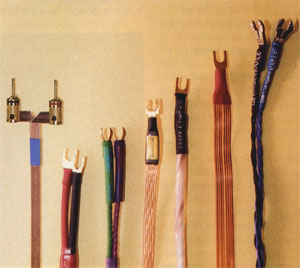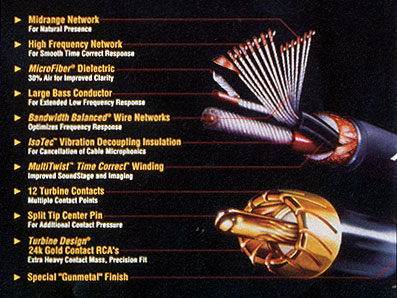Critical Listeners Crave Copper Cable
 Some of the many high-end copper speaker cables available from The Cable Company and other distributors of specialty audio cable. Products shown are from Alpha-Core, Inc., XLO, Kimber Kable, Music Metre, Nordost, Tara Labs and Straight Wire.
Some of the many high-end copper speaker cables available from The Cable Company and other distributors of specialty audio cable. Products shown are from Alpha-Core, Inc., XLO, Kimber Kable, Music Metre, Nordost, Tara Labs and Straight Wire.Would you pay $900 per foot for speaker cable to ensure a completely neutral effect on the sound from your stereo? "Yes" is the answer, if you're one of the rare breed willing to spend $50,000 to $100,000 or more for the ultimate in a home entertainment center. Jack King, technical marketing manager for Kimber Kable, Ogden, Utah , reports that his firm is enjoying an eight-months' backlog for its eight-foot-long solid-silver speaker cables priced at $15,000 a pair.
Copper cables dominate the market, however, and are a real bargain, ranging from about $1.50 to $150 per foot. Glenn Beinstock of The Cable Company, a direct marketer located in Point Pleasant, Pennsylvania, says he stocks no fewer than 60 different brands of audio cable. He admits that as enthusiasts upgrade to more and more costly cabling, all they achieve are "incremental improvements." What about silver versus copper? "In some instances, silver cabling actually results in poorer performance compared to copper," Beinstock answers. [Ed. note: Silver is the only metal with higher electrical conductivity than copper.]
For Kimber and its several dozen competitors, copper is the primary conducting material, and the prices are an order of magnitude lower. Kimber's cables are braided of strands with different gauges. For instance, its Teflon-coated cables contain seven strands of five different gauges, all of round cross section.
According to President Ray Kimber, some of the copper he uses is "purer than oxygen free." [Ed.note: C10100, oxygen-free electronic (OFE) is 99.99% copper, minimum.] Just how Kimber obtains a more highly refined copper from his base stock is his trade secret, but he reveals that "trace elements are added to the copper to improve manufacturability." These proprietary trace ele ments are dissipated during manufacture, so competitors won't be able to determine their nature by analysis of end products, according to King.
Noel Lee, founder and pres ident of Monster Cable, South San Francisco , California , is also a devotee of OFE copper. No silver is used in any of his high-end cables, which are woven with as many as 1,000 strands of two or three different gauges. Some terminations, however, are plated with gold. Monster Cable, founded in 1978, is the volume leader in high-end audio cable, a niche industry dominated by U.S. manufacturers.
Monster Cable and others have expanded beyond home stereo systems and entertainment centers to promote their cables in recording studios and in car stereo systems. Lee claims he recently landed an order for $100,000 worth of cable for a new recording studio in Brussels, reportedly the largest on the Continent. Many popular singers record in studios using Monster Cables. Background music for major films, such as "Jurassic Park," is also recorded in the same studios.
Ulrik Poulsen, president of Alpha-Core, Inc., notes that there's "only a marginal difference" between his firm's silver and plain copper audio cables. Utilizing a design by Ole Goertz, a Danish audio expert, Alpha-Core, located in Bridgeport, Connecticut, offers cable in a flat busbar form. The copper, again, is C10100. Since the 0.4- to 0.8-inch wide solid conductors are insulated with transparent plastic (Lexan ®), they are deliberately installed in plain view by some aficionados to enhance their systems with a "high-tech" look, according to Poulsen. Alpha-Core's cables are priced upwards from about $4.00 per foot and are claimed to eliminate distortion.
High-tech copper cabling isn't limited to speaker connections. It is also used to interconnect the other components of home entertainment systems, such as FM tuners, CD players, VCRs and TVs. Some manufacturers also use high-end cable for connections inside their audio components, mainly amplifiers. There are even high-tech power cables designed not to pick up any extraneous signals (electromagnetic and radio frequency interference). Ray Kimber says even if you use an AC power line conditioner, you should still use a high-tech power cable; "they act synergistically."
 Audio interconnects from Monster Cable are woven with as many as 1,000 strands of oxygen-free electronic copper wire.
Audio interconnects from Monster Cable are woven with as many as 1,000 strands of oxygen-free electronic copper wire.Since benefit of costly cabling is very much in the perception of the listener and closely related to the quality of the other components, how do hi-fi enthusiasts choose among the many competing designs? "Dealers lend sets of cabling to good customers who try them out in their systems," according to John Atkinson, editor, Stereophile magazine, Santa Fe, New Mexico.
This small American industry which manufactures expensive audio cabling is contributing positively to the balance of payments. From the day he founded Monster Cable, Noel Lee has strived for exports. Today, his company sells a lot of cable in Europe and the Far East. Kimber Kable also does a substantial export business.
There are many foreign hi-fi publications, including a Chinese edition of Stereophile magazine. Most promote sales of high-end copper cabling and other U.S.-made audio products. Atkinson adds, "Sales of high-end cable are strong in the Pacific Rim, because keeping up with the Joneses is a powerful factor." [Ed.note: Less demanding listeners can find two-conductor, 16 or 18 AWG stranded copper wire at the local hardware store for about a quarter per foot.]
Alpha-Core, Inc.: 203/335-6805.
The Cable Company: 800/328- 9973.
Kimber Kable: 801/621-5530.
Monster Cable: 800/995-2886.
Also in this Issue:
- Critical Listeners Crave Copper Cable
- Copper Protects Motors Chemical Surprise Improves Lubricants
- Copper Helps Heal Wounds
- Copper Has Key Role in Healthy Hearts
- Protecting Bronze Against Pollutants
